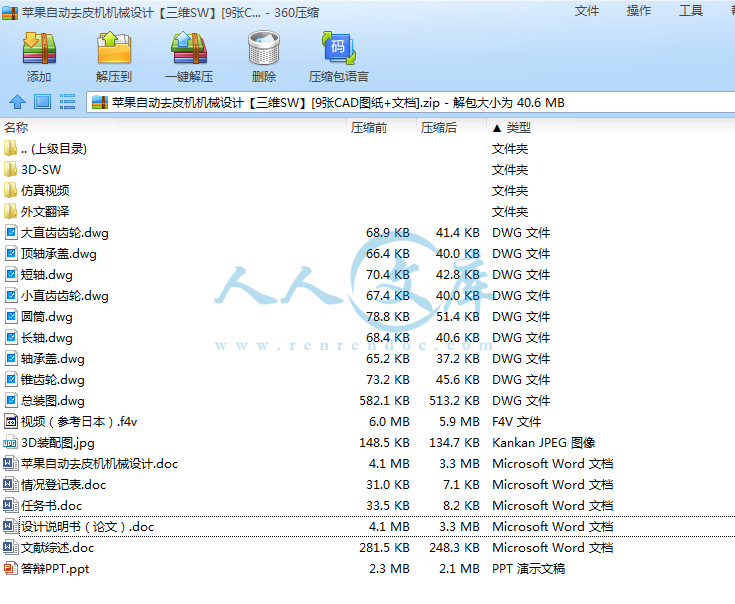【温馨提示】 购买原稿文件请充值后自助下载。
以下预览截图到的都有源文件,图纸是CAD,文档是WORD,下载后即可获得。
预览截图请勿抄袭,原稿文件完整清晰,无水印,可编辑。
有疑问可以咨询QQ:414951605或1304139763
摘要
现阶段我国苹果的生产相对较好,但是在加工方面和西方国家相比就有相当大的差距,在加工自动化方面更是落后。我国现在水果罐头行业的发展相对比较乐观,并且消费者对水果罐头的需求越来越大。水果罐头需求大,当然少不了苹果罐头,但我国现有的苹果去皮设备中存在着不少问题,比如大型设备体积庞大,加工过程苹果容易受污染,且不适合小型企业加工,另外有一部分设备需要靠人工将苹果逐个插到固定针上,这样很容易造成工人受伤事故。
本文设计的苹果自动去皮机主要适用于小型苹果罐头加工企业,不再需要人工将苹果逐个插到固定针上,而是采用自动检测系统,通过气缸将苹果插到固定针上。有手靠近苹果托盘是机器将不动作,这样就减少了不必要的人员事故。本设计内容主要包括苹果自动去皮机总体设计、零件设计、零件尺寸设计及计算、标准件的选择、重要部分强度校核等。并且还绘制了所需零件的所有CAD图和PROE整装图。
关键词:水果罐头,苹果自动去皮机,设计
Abstract
At the present stage, apple production in China is relatively good. But there is still a considerable gap in the aspect of processing compared with western countries, especially more backward in terms of process automation. In our country the development of canned fruit industry is recently boom recently, at the same time the demand for canned fruit is growing with more and more consumers loving them. Canned fruit is in great demand, so it is canned apple. However, there are still many troubles in our existing apple peeling devices, such as the large volume of large scale equipment, apple being vulnerable to pollution in the process procedure, as well as unsuitable for small business processing. Another drawback is that some devices depend on artificial to insert apple one by one into fixing pins, which is easy to cause injury accidents.
Apple peeling machine automatically in this artical is mainly targeted at small apple canned food processing enterprises. Instead of depending on artificial to insert apples one by one into fixing pins, the design brings to automatic test system and apples are inserted into fixing pins through the cylinder. We can find out one advantage is that the machine doesn’t work if workers’ hands close to apple tray so as to reduce the unnecessary accidents and improve the security. The design mainly includes the overall design of automatic apple peeling machine, detailing design, the design and calculation of component size, the choice of the standard component, and the intensity check to important part. What’s more, all CDA chart and PROE diagram of all necessary components are drawed well.
Keywords: canned fruit, apple automatic peeling machine, design
目录
摘要 I
Abstract II
1 绪论 1
1.1 本设计研究的目的与意义 1
1.2 现阶段国内苹果去皮方式 1
1.3 苹果自动去皮机的研究状况及存在问题 2
1.3.1 苹果自动去皮机的研究状况 2
1.3.2 苹果自动去皮机存在问题 2
1.4 本设计研究内容、方法及方向 3
1.4.1 本设计研究内容 3
1.4.2 本设计采用的方法 3
1.4.3 本设计未来发展方向 3
2 苹果自动去皮机总体方案设计 4
2.1 苹果自动去皮机方案确定 4
2.2 苹果自动去皮机工作原理及结构组成 4
2.2.1 苹果自动去皮机工作原理 4
2.2.2 苹果自动去皮机结构组成 4
2.3 苹果自动去皮机工作流程 4
3 苹果自动去皮机运动机构确定 6
3.1 送料机构的确定 6
3.1.1 送料机构方案设计 6
3.1.2 送料机构组件的确定 6
3.2 工作台转动机构的确定 8
3.2.1 直齿圆锥齿轮的设计 9
3.2.2 直齿圆柱齿轮的设计 12
3.3 苹果自动去皮机去皮及苹果固定装置 19
3.3.1 刀架的设计 19
3.3.2 刀片的设计 19
3.3.2 苹果固定装置 20
4电机的选择 21
4.1 确定电机类型 21
4.2 步进电机参数 21
5 轴设计校核及轴承的选择 25
5.1 短轴的设计 25
5.2 短轴的校核 26
5.3 轴承的选择 29
6 苹果自动去皮机仿真图 30
结束语 31
参考文献 32
致 谢 33
1 绪论
1.1 本设计研究的目的与意义
由于水果罐头行业发展快速,且水果罐头行业发展前景相对较乐观,故不少小型水果罐头企业如雨后春笋般出现,企业要加工过罐头首要问题就是加工设备,对生产苹果罐头的企业而言,苹果自动去皮设备是重中之重,相对大型罐头企业应用的大型流水线型的生产方式,对小型加工企业并不适合,因此广大加工厂家就迫切需要有一种小型苹果自动去皮设备的出现,且该设备生产效率要高,安全性高。本设计就是响应广大厂家的要求,设计出能够很好适用于小型罐头加工企业。该设计产品还具有以下优点:1)能自动检测员工是否在手放于苹果固定针下,能防止员工误操作造成人工事故;2)该产品生产效率高,将苹果果肉损耗减少到最低;3)该产品还能对其他水果去皮,如梨。该产品的出现对小型水果罐头加工过厂家有着很大的帮助,对国内整个水果罐头行业的发展有个积极的推到作用。
1.2 现阶段国内苹果去皮方式
1)手工去皮
手工去皮有以下优点:苹果去皮彻底;果肉损耗小。但是手工去皮有不少缺点,如去皮效率低、人工去皮成本高、人工劳动强度大。因此手工去皮的方法并不适合于企业加工。





 川公网安备: 51019002004831号
川公网安备: 51019002004831号